How to diff XML
Lennart Regebro
wroc.py, April 2019
BriteCore is the leading technology platform for modern insurance providers. Fully managed through Amazon Web Services cloud, BriteCore is continually updated to guarantee maximum security, efficiency, and durability at scale. Over 45 Carriers, MGAs, and InsureTechs rely on BriteCore for their core, data, and digital needs.
I work for BriteCore.
We do the type of software that insurance companies use to deal with insurance policies and claims.
We are over a 100 people right now, we work remotely, and yes, we are hiring. I'm not currently involved in the hiring procedures, but I will be in the future. Go to britecore.com, there's a careers link in there somewhere, I'd love it if we got more people in Wroclaw.

However, when I did the stuff I'm talking about here, I worked for another company, called Shoobx.
Shoobx does a lot of cool things that involve legal documents, and long story short, if you have a Delaware C-Corp, you need Shoobx. If you are gonna do a US startup, you need Shoobx.
They ALSO hire people remotely, but only senior level developers, and the stuff they do is HARD. Just so you know. Contact them if you think your job is too easy.

At Shoobx they deal a lot with legal documents. Although you can print your legal docs and sign them with a pen and then scan them into our system, one of the benefits of Shoobx is that you don't have to do that.
SBT + magic = PDF
You can create the legal document in Shoobx and sign everything electronically. There are workflows for doing all this and filling in documents, you can customize them and loads of things I only understand halfway because I'm not a lawyer.
So we have loads of documents, many of them generated through our own template language, unsurprisingly called "SBT" for "Shoobx templates". (Psst, it's really mostly Reportlab RML + Zope Page Templates + XSLT magic).

Both documents and templates can have revisions, and of course it would be nice to have a way of showing the differences.

Obviously a text diff won't do, we need the sort of WYSIWYG difference where inserts are shown in green, and deletes are shown in red and with a strike through.
The first effort of making a diff for templates worked, but has less than optimal results. It was implemented by someone else than me, and I'm told it took a month or so. Clearly faster programmers than me at work.
xmldiff 0.6
Diffing XML was trickier than we thought, and why not use somebodies library? So, we took over maintenance of the xmldiff library. It existed, seemed to work, but was un-maintained, which is why it wasn't used from the start.
It isn't only a library, it's also a command line tool.
I was tasked with implementing document diffing based on xmldiff.

That wasn't hard, but it also didn't give nice diffs.
What you can see here is that instead of inserting a new paragraph three, and then changing the numbering, it modifies paragraph three, reinserts it as paragraph 4. It's worse than this, because it then deletes paragraph 4 and reinserts it as paragraph five, and only then does it start to change the numbering, as it should do from the start.
The output was no good
There was a memory leak in the C code
My C coding skills are rusty
It was hard to maintain
And some infinite loop somewhere
And it was really hard to improve the matching
So, the output was no good. But that wasn't the only problem with xmldiff.
- -> There was a memory leak in the C code. -> I haven't done any major programming in C since the 90s, and this had it's central parts in C.
- -> The Python code was very fond of one or two letter variable names, like typical C, so yeah, it was hard to read. The internal data structure was a hierarchical list of lists with the parent list contained in the child list, so just infinite loops of lists of lists.
- -> And there was some infinite loop somewhere, maybe because of the data structure?
- -> And it was really hard to improve the matching, for reasons I'll come to later.
xmldiff (again!)
Almost entirely incompatible
Pure-python
Better results
Easier to use as a library
Supports writing formatters!
For these reasons I ended up scratching all of xmldiff, and writing a new library, which we after some discussion and deliberation decided to call <fanfare> xmldiff! This has been released as xmldiff version 2, current version is 2.3.
->Almost entirely incompatible
->Pure-python
->Better results
->Easier to use as a library
->Supports writing formatters! (I'll explain formatters later)
How do you diff?
Match
Edit
Output
So, how DO you diff? Before we talk XML, let's look at a simpler diff case: Text files.
There's three stages to diffing. Matching, edit, output.
Matching
In text files when you want to show a diff in a readable way, diffing is typically done line by line, so matching is easy: Are two lines exactly the same? Then they match.
But how do you match? Just going line by line and comparing? No, you use an algorithm called Longest Common Sub-sequence.
Longest Common Sub-sequence
Old: 1 2 3 4 5 6 7 8
New: 5 2 3 4 7 5 3 8
LCS: 2 3 4 5 8
Basically you look for bits that are the same and come in the same order.
Compare the ->old list, with the ->new list, and we get an ->LCS list. The longest list of items where all items are in the same order in both files.
For a text file, you run lcs on the lines. From this we get a list of lines that match.
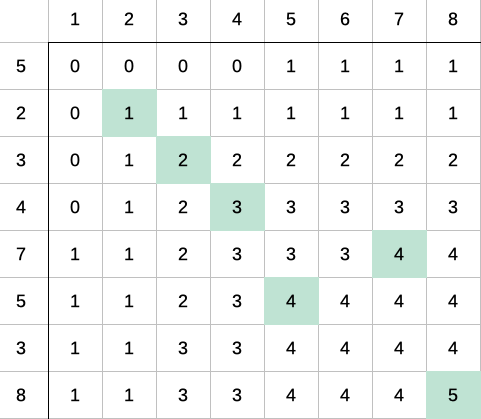
Longest Common Sub-sequence, in theory, makes a grid of all items vs all items, and maps out how many characters in common you have.
As you see, this grid gets quickly larger with increasing file sizes. It can use a lot of memory, typically time and memory is quadratic.
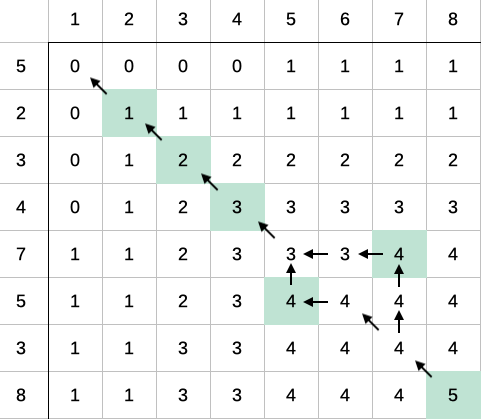
After generating this grid, you then walk through the grid backwards to find the shortest path from one corner to the other corner. That's also slow.
But I read through a lot of implementations of LCS, and I found a few tricks. The most common one is to keep track of how you got to each grid, which speeds up the backtracking, but uses even more memory.
One implementation I found by someone called Chris Marchetti actually makes the more sensible thing of building up paths instead of building a grid, and then choosing the shortest path. This saves a lot of memory.
Another good trick to speed it up is to compare the start and the end of the sequences, and skip anything that is equal there.
The end result has 30 lines of actual code, so it's fairly compact and fast, but I'm sure it still can be improved. If you like that kind of challenge to make this faster or use less memory please dig your teeth into it.
Editing
Delete 3 Insert 9 at position 3 Delete 5 Insert 5 at position 6 Delete 8 Insert 7 at position 8
After matching comes editing.
From the list of matching nodes we generate an edit script, which is a list of edit actions that turn file1 into file 2. The edit actions are basically "delete lines x-y", insert line at z, etc.
Edit scripts should preferably be compact, so they can be used to store different versions in a change management system, without using up silly amounts of space. The output of course have no such requirement, it should instead be easy to read.
Output
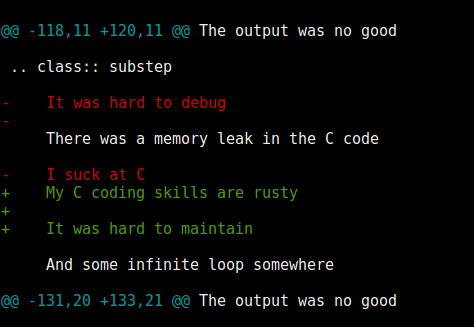
And then we use that edit script to make a nice looking output.
Not so hard, is it? But if XML was this easy, I wouldn't have a talk. So, how to do it?
Matching XML
<para section="3"> <b>3. </b>Lorem ipsum have some gypsum </para>
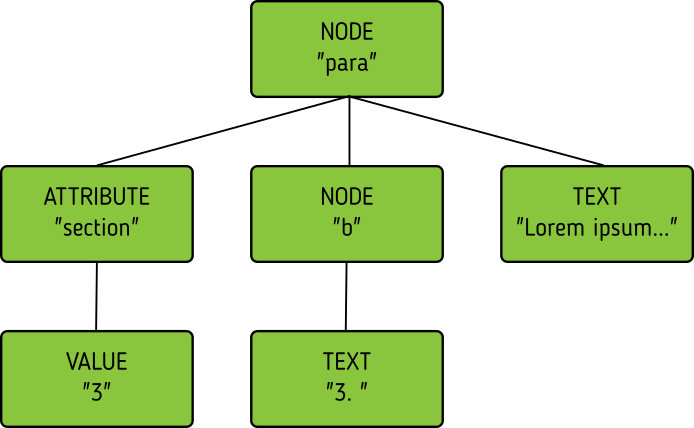
First of all, the matching. We don't match lines or texts, we match nodes.
The node matching is tricky for XML. Scientific papers on hierarchical diffing generally view hierarchies as nodes that have a value, and children, and that's it.
So, xmldiff 0.6 made something clever here, it converted one complex XML node to many simple nodes.
-> For example, these two nodes, a para node and a b node, gets converted into six simple nodes.
-> Now every node only has an type, a value, and children.
Comparison is now easy!
A new version
<para section="4"> <b>4. </b>Lorem ipsum have some gypsum </para>
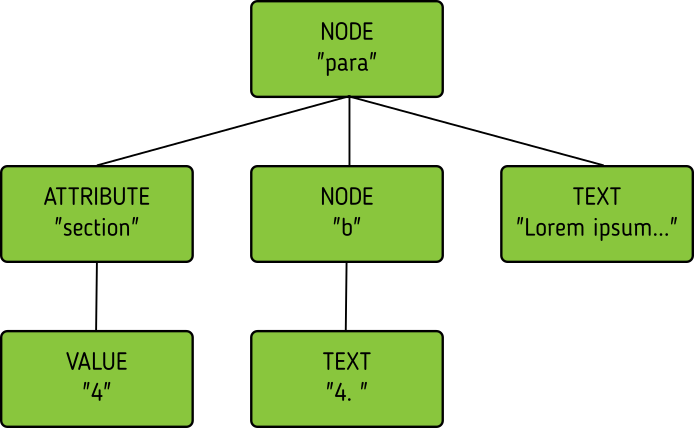
But clever is always dangerous in computing...
What happen if we insert another paragraph node before this node? Well, the number changes, which changes the value in two nodes.
When xmldiff is to make a diff and compare these two nodes, it will first notice that the two nodes with numbers have changed, those values are different, so the nodes don't match any more.
Their parent nodes; the section attribute and the b node, they now have no children in common with the old version of the tree. So they don't match.
No match!
<para section="4"> <b>4. </b>Lorem ipsum have some gypsum </para>
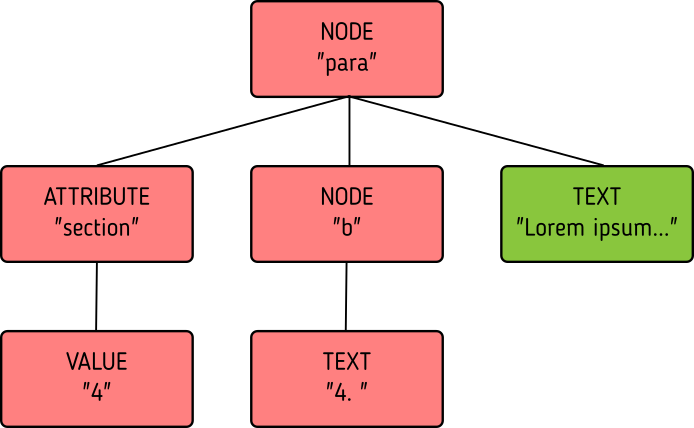
Which means the top node has two out of three children that do not match, so it doesn't match.
So to us, these nodes are obviously the same, just different numbering, but to xmldiff it was obviously NOT the same node, and the result is what we saw before.
Bad matchings
Node:
<para section="3"> <b>3. </b>Lorem ipsum have some gypsum </para>
Value:
"section:3 Lorem ipsum have some gypsum"
You need to look at a node as a whole, not as independent pieces.
I make a string out of the nodes attributes and it's texts, and then use the standard library's difflib to get a similarity ratio out of that. And that actually uses the Longest Common Sub-sequence method I mentioned before. If the node has children, I also take that into account in equal measure to the difflibs ratio.
This works, but there is a lot of room for alternatives here. I've f ex tried dealing with attributes separately from texts, so that there could be different weights for text, children and attributes. But I haven't been able to significantly improve what I have right now, which I arrived at more or less by trial and error.
Matching procedure: LCS?
Fast, bad matching
Longest common sub-sequence can be used in theory. You can flatten both trees with a traversal, and then use LCS on that, -> but it leaves a lot of nodes unmatched that could be matched. It also means you don't always find the best match, only a good enough match, which is far from optimal.
The diffs get very big, not at all compact as we want them
Compare all nodes to all nodes
Nightmarishly slow
Finding the best possible match over two big sets is often called the stable marriage problem. And there are algorithms for this, but since you need to check what the best possible match is for all nodes, you really need to compare every node to every node. ->
That would have been crazy slow.
Single-iteration best match
Good enough!
What I did early on was simply to go through each node from one tree and find the best match for that node, and then remove both nodes from the lists of unmatched nodes. That means that the best match from the perspective of one tree always wins, but that's not always the best match from the perspective of the other tree. But this gives a decent match for our use case.
It was also the recommended way in the main paper that we used on how to do hierarchical diffing.
This could take almost two minutes for some of our documents, so I hope you forgive me for not even trying the previous stable marriage algorithms, which are even slower.
XML edit actions
DeleteNode, InsertNode, RenameNode, MoveNode
DeleteAttrib, InsertAttrib, RenameAttrib, UpdateAttrib
UpdateTextIn, UpdateTextAfter
InsertComment
Where a linear file can get away with just two actions, insert and delete, and if they want to be fancy, a move action, xml needs more.
-> We can rename nodes as well, so we get four actions, -> And we can delete, insert rename and update attributes. -> And, you can update texts, both inside and after a node. -> And you need a separate action to insert comments, as they aren't real nodes.
So, eleven different actions. And notice we don't support moving attributes or texts, in theory we could have that as well, but detecting moves of attributes and nodes would take quite some extra processing power to detect, so we skip that.
Making the edit script
Walk the "new" tree, node by node.
If it has a match, look for differences.
If there is no match, insert it!
Delete all nodes from the old tree with no match.
Now we have a list of node matchings, and from that we should make an edit script.
-> So we go over the tree again, node by node.
-> If that node has a match, we must look at what the differences are. In the plain text case we can match on equality, but for complex nodes like XML we can't, because like with the renumbering case we would get a lot of misses when we should have had matches.
-> If it does not have a match, insert it!
-> Lastly delete all nodes from the "old" tree without a match.
Generate output
[update-attribute, /para[1], section, "4"] [update-text, /para/b[1], "4. "]
We can of course just print out the edit script. But as I mentioned, we want that nice GUI diff. How do you do THAT?
What we want is an XML output that we still can render to a document, but which includes diff information. We want maybe something like this:
End Result
<para section="4" class="modified"> <b><span class="delete">3</span> <span class="insert">4</span>. </b> Lorem ipsum have some gypsum </para>
Something that has classes that we can add styles to. So the delete class can be for example, a red font with a strike through! So how can we get there? Xmldiff 2 includes formatters for different outputs, including one just called "XML" that will give this sort of output:
XML Output
<para section="4" diff:update-attr="section:3"> <b><diff:delete>3</diff:delete> <diff:insert>4</diff:insert>. </b> Lorem ipsum have some gypsum </para>
The translation of these tags to span tags or class attributes is fairly straightforward with XSLT, although it of course depends on your XML format. If it's very complex, then the XSLT can get very complex as well.
XSLT gotcha
<app:term name="expenses" set="advisor" allowCustom="True"> <app:option name="own_cost"> <whatever/> </app:option> <app:option name="reimburse"> <blahblah/> </app:option> </app:term>
We have XML that looks like this. It's basically a sort of app-specific switch statement.
And we have XSLT that deals with this.
This means that the whatever section will be used if the "expenses" term is set to own_cost, but the blahblah section is used if expenses is reimburse.
So how is this implemented?
<xsl:value-of select="sbx:getFieldTitle($content-expr)" />
It's implemented by having the XSLT call a function! Yes, in XSLT you can call functions, and with lxml, which we are using, those can be python functions.
But, if app:option is not a child of an app:term, that function would break! Now how can that happen after diffing? Well, it's a node mismatch again. In one version the whatever section of the document might be inside one of these app:term/app:option tags, and later version, that section is inside some other sort of tag.
And this can lead to a mismatch. Some nodes attributes and content is very similar to the app:term, so we get a match!
<section name="expenses" allowCustom="True" diff:rename="app:term" diff:delete-attr="set"> <whatever diff:delete="" diff:insert="" /> <app:option name="bear_own" diff:delete=""> </app:option> <app:option name="reimburse" diff:delete=""> <blahblah/> </app:option> </section>
The end result is XML that looks somewhat like this. Note now that the app:option tags now are deleted, but more importantly, the app:term has been renamed and one of the attributes have been deleted. This breaks the Python function that is being called!
So you have to either fix the function so it doesn't break in this case, or modify the XSLT so that it isn't called for deleted nodes.
But most likely you don't do this advanced stuff, so you might think "Ooh, I'm gonna diff my HTML docs with xmldiff!" and then we come to the next problem!
LCS on text

Another problem we get here is how to match text. If we just use LCS on the text, we'll get very hard to read diffs.
diff-match-patch

So we need some sort of semantic diffing there, a diff that understands words. So we decided to use Googles diff_match_patch library modules.
diff-match-patch
No proper releases
Different modules for Py2 and Py3
It doesn't have proper releases on PyPI, so we actually include it in xmldiff, and we include both the Python 2 and the Python 3 version. I have a makefile target to update them to the latest version before release.
Formatted text
Old:
<p>This is formatted text</p>
New:
<p>This <b>is</b> formatted <i>text</i></p>
But formatted text has it's own little issues, that semantic knowledge of the text doesn't help with!
For example, if you simply add a bit of formatting to some text, you have very big effects.
The text of the P-node has changed from "This is formated text" to just "This". The node also have two new children.
The old P node and the new P node will not match. Oy vey, what to do?
Unicode stubs
<p>This \ue000is\ue001 text that can have \ue002formatting\ue003</p>
We replace tags with unicode characters before the diffing. This means the nodes will match, but since the contained text isn't the same we get an edit script action to update that text.
The formatter that outputs the XML will insert these stubs before diffing and replace them back with the correct tags after diffing.
And the characters used are from the Private User Area in Unicode, don't worry.
It's from the small 16-bit area in Unicode so it works on narrow builds of python, once Python 2 support is dropped it will be another larger unicode area, but you are unlikely to run out of replacement characters in any case.
Unicode stubs
<p>This <b diff:insert="">text</b> that can have <i diff:insert="">formatting</i></p>
And we get a good result!
So! slow!
Stop looking when you find perfection
Use faster algorithms from difflib
Implement the LCS "fast-match" algorithm
Caching
The first versions of the new implementation of xmldiff was very slow. The worst diff case we had took more than one and a half minute. So I went on to trying to improve that, making the matching faster etc.
One of the biggest speedups was implementing a shortcut. -> If any match was 100%, then we'd stop looking for better matchings. -> I also added a flag to choose between three different ways of calculating how different two nodes are, "accurate" (the one used in 2.0), "fast" (good enough) and "faster" which is only so-so.
-> And I added a fast-match option, which uses LCS as a first step to find matches quick, and then do the slower algorithms on the unmatched nodes. -> Also a bit of caching.
Harder, Better, Faster, Stronger
xmldiff 0.6: 8 seconds
xmldiff 2.0: 100 seconds
xmldiff 2.1: 5 seconds
With faster ratio-mode: 2 seconds
With fast-match: 1.5 seconds
By the end, I had gotten the time down for a typical XML document to 20% of the time. In our worst case example, -> xmldiff 0.6 took 8 seconds. -> xmldiff 2.0 took a 100. -> But I got that down to 5.1, and with less accurate matching, down to 3, and with the LCS fast-match algorithm to 1.5 seconds.
So yes, we get better matching AND faster diffing, even in pure python.
How can YOU use it?
>>> from xmldiff import main >>> main.diff_files( ... "../tests/test_data/insert-node.left.html", ... "../tests/test_data/insert-node.right.html") [UpdateTextIn(node='/body/div[1]', text=None), InsertNode(target='/body/div[1]', tag='p', position=0), UpdateTextIn(node='/body/div/p[1]', text='Simple text')]
You can of course use it from the command line, but that's not so exciting. What you really want to know is how to use it from Python!
Well, it has a very simple API, here is one example, to diff two files. The result you get in that case is an edit script.
XML Output
>>> from xmldiff import formatting
>>> formatter = formatting.XMLFormatter(
... text_tags=['p'], formatting_tags=['i', 'b'])
>>> main.diff_files(
... "../tests/test_data/insert-node.left.html",
... "../tests/test_data/insert-node.right.html",
... formatter=formatter)
<body xmlns:diff="http://namespaces.shoobx.com/diff">
<div id="id">
<p diff:insert="">Simple text</p>
</div>
</body>Or you can specify the XMLFormatter to get XML output. The text_tags argument are a list of tags that contain formatted text, which enables the unicode substitution I mentioned before. A list of formatting_tags is there to enable the feature that reformatted text isn't shown as deleted with one format and inserted with another, but the text is instead shown in a way that makes clear that only the formatting has changed. How that is is up to you, but maybe with a yellow background?
Future
We ain't stopping now!
We're trying to fix bugs quickly, and so far it's been pretty good. We have some requests for more options when matching, for more control for your specific use case, but not much information to go on there, it seems mostly like theoretical questions from potential users.
But yeah, we'd like more flexibility when matching, and it would be nice to have a stable marriage algorithm, maybe it won't get terribly slow.
